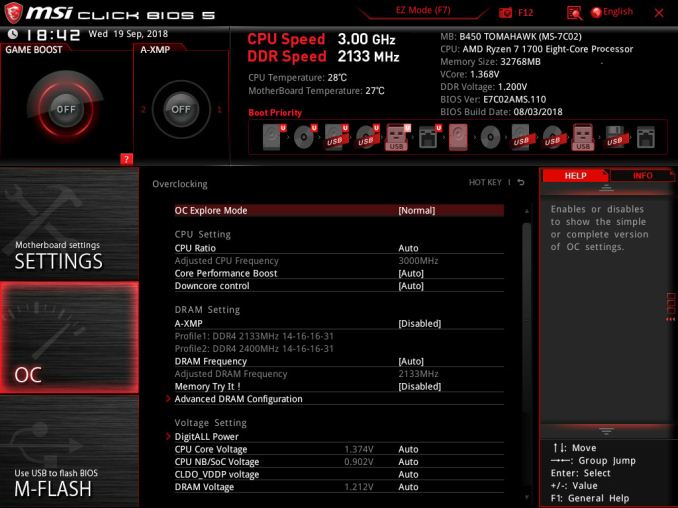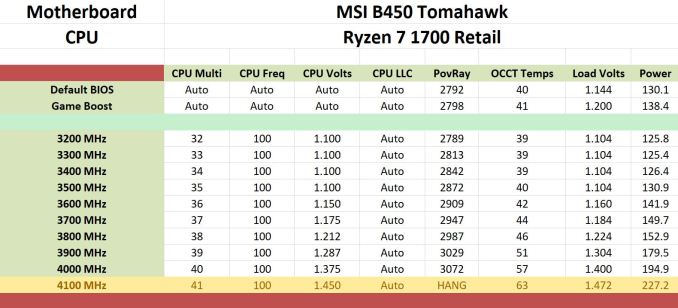The MSI B450 Tomahawk Motherboard Review: More Missile Than Axe
by Gavin Bonshor on December 11, 2018 8:00 AM EST- Posted in
- Motherboards
- AMD
- MSI
- Zen
- AM4
- Ryzen
- Tomahawk
- Ryzen 2
- B450
- Entry Level
- MSI B450 Tomahawk
Ryzen Overclocking
Experience With the MSI B450 Tomahawk
Aside from the very basic and barebones A320 chipset, all of AMD's other AM4 chipsets which includes B350, X370, B450 and X470 all allow for overclocking. This is great for users with the right components to push their processors and memory above and beyond the default settings. From glancing over a lot of different boards specifications from the main vendors, a lot of focus has been on power deliveries and packing them full of unnessesary doubled inductors without a true increase in quality. MSI has been one manufacturer to bolster and upgrade their power deliveries and the differences between the B350 Tomahawk and this newer B450 Tomahawk are more than enough to paint a picture from MSI that overclocking and stability is a key area they've improved upon.
When it came to overclocking our Ryzen 7 1700 processor within the MSI Click BIOS 5 firmware, all of the key options required to overclock the processor was found within the OC section. Users looking to apply the Game Boost pre-defined overclocking profile can do so from the initial EZ mode splash screen by clicking the button to the ON position. This will apply different settings depending on which model of processor you have installed, but for our Ryzen 7 1700 this meant it would overclock our chip to 3.2 GHz with a CPU core voltage of 1.2 V. Manually overclocking was painless as pushing our chip to its maximum stable core frequency of 4.0 GHz required two settings to be altered; the CPU ratio to x40 and the CPU Core Voltage to 1.375 V. One thing to note was when the CPU Core Voltage setting was altered from auto, it would disable AMD's Cool'n'Quiet power saving feature. The maximum CPU core voltage the B450 Tomahawk supports is 1.55 V which is considered overkill and could dramatically reduce the lifespan of the processor when left under 24/7 conditions and a maximum recommended CPU VCore of 1.45 V with adequate CPU cooling; I would recommend staying below 1.4 V for a good balance of core frequency, power draw and core temperature when using a decent CPU cooler.
Our Ryzen 7 1700 CPU has a limit of around 4.0 GHz with a voltage range of 1.36-1.40 volts which is ultimately down to the quality of the silicon within.
Methodology
Our standard overclocking methodology is as follows. We select the automatic overclock options and test for stability with POV-Ray and OCCT to simulate high-end workloads. These stability tests aim to catch any immediate causes for memory or CPU errors.
For manual overclocks, based on the information gathered from previous testing, starts off at a nominal voltage and CPU multiplier, and the multiplier is increased until the stability tests are failed. The CPU voltage is increased gradually until the stability tests are passed, and the process repeated until the motherboard reduces the multiplier automatically (due to safety protocol) or the CPU temperature reaches a stupidly high level (100ºC+). Our test bed is not in a case, which should push overclocks higher with fresher (cooler) air.
Overclocking Results
Enabling MSI's Game Boost on our Ryzen 7 1700 didn't really improve performance within POV-Ray when compared to default settings, with the only variables different came through a 1.2 V CPU VCore at maximum load and an 8 W higher power draw. Manually overclocking in 100 MHz increments gave POV-Ray performance a steady increase throughout the different straps and as expected, maximum power draw and temperatures at full load did so as well. Up until settings of 4.0 GHz and a CPU core voltage of 1.375 V was applied, VDroop control was exceptionally well and above 3.8 GHz seemed to make the B450's discipline of voltage look a little lax. Overall this board formidable option for good overclocks and with better power delivery heatsinks than previous first generation AM4 motherboards, the B450 Tomahawk is well equipped.












36 Comments
View All Comments
kn00tcn - Sunday, December 16, 2018 - link
buildzoid has said gigabyte went backwards in memory support for their second gen mobos16gb sticks are more demanding, 32gb total is more demanding
you dont 'need' to buy bdie, but you should be aware of various aspects that can hurt stability
XMP doesnt mean much, the secondary timings are not in the profile, the mobo has to make them up, the mobo may not even be sending clean or high enough voltage, the mobo can cause multiple problems already & that's before the cpu's memory controller variance is even looked at
plonk420 - Friday, December 14, 2018 - link
yeah, i got the B450M Mortar on the suggestion of Buildzoid and am loving it! took my VRM temps at 1700X stock speeds from 87C on the AB350M-DS3H with its wickle cooler to 65C on the Mortarkn00tcn - Sunday, December 16, 2018 - link
if you're still around to read this, i have booted a mortar to 3466 on hynix m-die (gskill trident z 2x8gb) with mostly auto settings, but it was unstable of course (not like i expect hynix to run at this speed at c16)how can you refuse to believe something you have no statistics on? what cpu was it? 32gb is more demanding than 16gb, dual rank is more demanding than single rank (rank not channel, 16gb sticks are likely dual rank)
try 2T CR, try geardown & bankgroup enabled, try 1.36 or 1.37v, try 1.1v soc
kn00tcn - Sunday, December 16, 2018 - link
*using 2600x cpu, stock coolerrocky12345 - Monday, December 17, 2018 - link
I'm not sure it is the retailers fault that the board is not working for you now. They did not do a bios flash and render the board dead now did they. When you installed the board yes it had problems seeing both of your memory sticks and that was because of it having a older bios firmware installed.The fault is that of MSI them selves for having a newer bios that does not seem to be working properly on this model of board. With all of that said the most the retailer can do is offer to take the board in and try to get it working for you and if they are nice won't charge you anything or if they do want to charge maybe a really small fee (since it was them that flashed the board making it useless now.)
As a retailer myself I would offer to take the board in and get it working for free. My own thoughts are because of the board first having issues with your memory sticks on the older bios that is where the problem is. If they took the board in and tried to fix it any good tech with that information in hand would very quickly pull your memory out and use actual memory that is known to work with these boards without problems and then do the flashback again. Chances are that is when the problem will be corrected and you would have a fully functioning board again.
I do think it is good of you not to mention names at this point. I do think that if they have a decent tech on staff this should be a easy fix for them and get you running again. Now if you just want to return the board for the sake of returning it then that is up to them if they want to do that or not. The board is either going to end up fixed or sent back to MSI for replacement. Now if it does end up going back to MSI who pays for the shipping MSI,the retailer or you that is the question.
0ldman79 - Tuesday, December 11, 2018 - link
Can you overclock using p-states with this board?I still use all of the various power saving features on all of my systems, my FX, my Core i5, i7 and Xeon and all but the laptops are overclocked.
I guess I got spoiled with my FX, I could alter base, turbo 1 and turbo 2 settings individually and keep Cool-n-quiet enabled. I'm looking for that capability on my eventual Ryzen build as well.
kn00tcn - Sunday, December 16, 2018 - link
should be some sort of PBO settingsCellar Door - Tuesday, December 11, 2018 - link
The audio on this board is absolute trash. Not even bad, terrible. It is muddy and with such poor amplification that if you have even an entry pair of headphones such as Audio Technica ATH-M50, you will be barely able hear stuff, and outright forget any soundstage or bass definition.I had no choice but to exchange it for a Asus B450-F - well worth the extra $25. In my 20 years in IT - I've seen better audio on 10 year old prebuilt Dell and no name PCs. MSI should be ashamed they are putting a 'gaming' sticker on this.
gavbon - Wednesday, December 12, 2018 - link
I had no issues with my Beyerdynamic DT770's 80ohm pair of cans.Cellar Door - Wednesday, December 12, 2018 - link
From this review - "our testing shows that the B450 Tomahawk performs the worst out of all the Realtek ALC892 equipped boards thus far."83.5db in the dynamic range - no offense but either those DT770 are being wasted on you or you never actually hear what they are capable of when properly amplified.